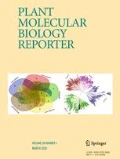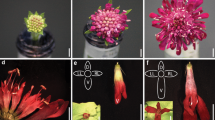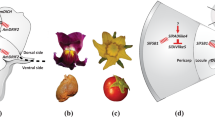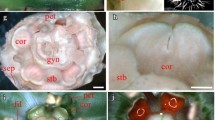Abstract
Undoubted lines of evidence point out that members of CYCLOIDEA (CYC) 2 clade are essential players to control flower symmetry and, amusingly, also are determinants of capitula architecture (pseudanthium). In several species, CYC-like genes influence the androecium patterning, but to date, the function of these genes in the development of gynoecium organs is less clear. In this review, we first reported details about floral symmetry and an overview of genes and molecular mechanisms regulating the development of zygomorphism in different angiosperm lineages (e.g., basal and core eudicots and monocots). Then, we paid emphasis on the role of CYC-like genes in the development of heterogamous inflorescence of sunflower as well as other Asteraceae and some species within the Dipsacaceae family. Helianthus annuus is particularly attractive because it represents a useful model to study the role of CYC-like genes on shaping floral corolla as well as the differentiation of reproductive organs in different flowers of pseudanthia. A special attention was reserved to inflorescence morphology mutants of sunflower (i.e., Chrysanthemoids2 and tubular ray flower) because they provide useful information on the role of CYC-like genes in the radiate capitulum evolution. Finally, we discuss data from literature to suggest that CYC-like genes are also co-opted to regulate stamen and carpel differentiation likely throughout their interaction with the cell cycle and flower organ identity genes. The recruitment of reproductive organs in ray flowers also supports the phylogenetic origin of a radiate inflorescence of sunflower from a discoid capitulum and suggests that in sterile zygomorphic ray flower primordia the latent identity to differentiate both microsporangium and macrosporangium was conserved.




Similar content being viewed by others
References
Abbott RJ, Ashton PA, Forbes DG (1992) Introgressive origin of the radiate groundsel, Senecio vulgaris L. var. hibernicus Syme: Aat-3 evidence. Heredity 68:425–435
Abbott RJ, James JK, Milne RI, Gillies ACM (2003) Plant introduction, hybridization and gene flow. Philos Trans R Soc B Biol Sci 358:1123–1132
Aggarwal P, Gupta MD, Joseph AP, Chatterjee N, Srinivasan N, Nath U (2010) Identification of specific DNA binding residues in the TCP family of transcription factors in Arabidopsis. Plant Cell 22:1174–1189
Aguilar-Martínez JA, Poza-Carrión C, Cubas P (2007) Arabidopsis BRANCHED1 acts as an integrator of branching signals within axillary buds. Plant Cell 19:458–472
Almeida J, Galego L (2005) Flower symmetry and shape in Antirrhinum. Int J Dev Biol 49:527–537
Almeida J, Rocheta M, Galego L (1997) Genetic control of flower shape in Antirrhinum majus. Development 124:1387–1392
Barreda VD, Palazzesi L, Tellería MC, Katinas L, Crisci JV, Bremer K, Passalia MG, Corsolini R, Rodríguez Brizuela R, Bechi F (2010) Eocene Patagonia fossils of the daisy family. Science 329:1621
Bartlett ME, Specht CD (2011) Changes in expression pattern of the TEOSINTE BRANCHED1-like genes in the Zingiberales provide a mechanism for evolutionary shifts in symmetry across the order. Am J Bot 98:1–17
Bartlett ME, Williams S, Taylor Z, Deblasio S, Goldshmidt A, Hall DH, Schmidt RJ, Jackson DP, Whipple CJ (2015) The maize PI/GLO ortholog Zmm16/sterile tassel silky ear1 interact with the zygomorphic and sex determination pathways in flower development. Plant Cell 27:3081–3098
Berger BA, Thompson V, Lim A, Ricigliano V, Howarth DG (2016) Elaboration of bilateral symmetry across Knautia macedonica capitula related to changes in ventral petal expression of CYCLOIDEA-like genes. EvoDevo 7:8
Berti F, Fambrini M, Turi M, Bertini D, Pugliesi C (2005) Mutations of corolla symmetry affect carpel and stamen development in Helianthus annuus. Can J Bot 83:1065–1072
Broholm SK, Tähtiharju S, Laitinen RAE, Albert VA, Teeri TH, Elomaa P (2008) A TCP domain transcription factor controls flower type specification along the radial axis of the Gerbera (Asteraceae) inflorescence. Proc Natl Acad Sci U S A 105:9117–9122
Broholm SK, Teeri TH, Elomaa P (2014) Molecular control of inflorescence development in Asteraceae. Adv Bot Res 72:297–333
Busch A, Zachgo S (2007) Control of corolla monosymmetry in the Brassicaceae Iberis amara. Proc Natl Acad Sci U S A 104:16714–16719
Busch A, Zachgo S (2009) Flower symmetry evolution: towards understanding the abominable mystery of angiosperm radiation. BioEssays 31:1181–1190
Buzgo M, Endress PK (2000) Floral structure and development of Acoraceae and its systematic relationships with basal angiosperms. Int J Plant Sci 161:23–41
Carlson SE, Howard DG, Donoghue MJ (2011) Diversification of CYCLOIDEA-like genes in Dipsacaceae (Dipsacales): implications for the evolution of capitulum inflorescences. BMC Evol Biol 11:325
Carpenter R, Coen ES (1990) Floral homeotic mutations produced by transposon-mutagenesis in Antirrhinum majus. Genes Dev 4:1483–1493
Chapman MA, Leebens-Mack JH, Burke JM (2008) Positive selection and expression divergence following gene duplication in the sunflower CYCLOIDEA gene family. Mol Biol Evol 25:1260–1273
Chapman MA, Tang S, Draeger D, Nambeesan S, Shaffer H, Barb JG, Knapp SJ, Burke JM (2012) Genetic analysis of floral symmetry in Van Gogh’s sunflowers reveals independent recruitment of CYCLOIDEA genes in the Asteraceae. PLoS Genet 8(3):e1002628
Citerne HL, Möller M, Cronk QCB (2000) Diversity of cycloidea-like genes in Gesneriaceae in relation to floral symmetry. Ann Bot 86:167–176
Citerne HL, Luo D, Pennington RT, Coen E, Cronk QCB (2003) A phylogenomic investigation of CYCLOIDEA-like TCP genes in the Leguminosae. Plant Physiol 131:1042–1053
Citerne H, Jabbour F, Nadot S, Damerval C (2010) The evolution of floral symmetry. Adv Bot Res 54:85–137
Citerne HL, Le Guilloux M, Sannier J, Nadot S, Damerval C (2013) Combining phylogenetic and syntenic analyses for understanding the evolution of TCP ECE genes in Eudicots. PLoS ONE 8:e74803
Clark JI, Coen ES (2002) The cycloidea gene can respond to a common dorsoventral prepattern in Antirrhinum. Plant J 30:639–648
Claßen-Bockhoff R (1990) Pattern analysis in pseudanthia. Plant Syst Evol 171:57–88
Claßen-Bockhoff R, Ruonal R, Bull-Hereñu K, Marchant N, Albert VA (2013) The unique pseudanthium of Actinodium (Myrtaceae)—morphological reinvestigation and possible regulation by CYCLOIDEA-like genes. EvoDevo 4(1):8
Coen ES (1996) Floral symmetry. EMBO J 15:6777–6788
Coen ES, Nugent JM (1994) Evolution of flower and inflorescences. Development Suppl:S107–S116
Coen ES, Nugent JM, Luo D, Bradley D, Cubas P, Chadwick M, Copsey L, Carpenter R (1995) Evolution of floral symmetry. Philos Trans R Soc B Biol Sci 350:35–38
Comai L (2005) The advantages and disadvantages of being polyploid. Nat Rev Genet 6:836-846
Corley SB, Carpenter R, Copsey L, Coen E (2005) Floral asymmetry involves an interplay between TCP and MYB transcription factors in Antirrhinum. Proc Natl Acad Sci U S A 102:5068–5073
Costa MMR, Fox S, Hana AI, Baxter C, Coen E (2005) Evolution of regulatory interactions controlling floral asymmetry. Development 132:5093–5101
Crews ST, Pearson JC (2009) Transcriptional autoregulation in development. Curr Biol 19:R241–R246
Cronk Q, Möller M (1997) Genetics of floral symmetry revealed. Trends Ecol Evol 12:85–86
Cubas P (2004) Floral zygomorphy, the recurring evolution of a successful trait. BioEssays 26:1175–1174
Cubas P, Lauter N, Doebley J, Coen E (1999a) The TCP domain: a motif found in proteins regulating plant growth and development. Plant J 18:215–222
Cubas P, Vincent C, Coen E (1999b) An epigenetic mutation responsible for natural variation in floral symmetry. Nature 401:157–161
Cubas P, Coen E, Zapater JMM (2001) Ancient asymmetries in the evolution of flowers. Curr Biol 11:1050–1052
Damerval C, Nadot S (2007) Evolution of perianth and stamen characteristics with respect to floral symmetry in Ranunculales. Ann Bot 100:631–640
Damerval C, Le Guilloux M, Jager M, Charon C (2007) Diversity and evolution of CYCLOIDEA-like TCP genes in relation to flower development in Papaveraceae. Plant Physiol 143:759–772
De Paolo S, Gaudio L, Aceto S (2015) Analysis of the TCP genes expressed in the inflorescence of the orchid Orchis italica. Sci Rep 5:16265
Della Pina S, Souer E, Koes R (2014) Arguments in the evo-devo debate: say it with flowers! J Exp Bot 65:2231–2242
Dezar CA, Tioni MF, Gonzalez DH, Chan RL (2003) Identification of three MADS-box genes expressed in sunflower capitulum. J Exp Bot 387:1637–1639
Dinneny JR, Yadegari R, Fischer RL, Yanofsky MF, Weigel D (2004) The role of JAGGED in shaping lateral organs. Development 131:1101–1110
Doebley J, Stec A, Hubbard L (1997) The evolution of apical dominance. Nature 386:485–488
Donoghue MJ, Ree RH, Baum DA (1998) Phylogeny and the evolution of flower symmetry in the Asteridae. Trends Plant Sci 3:311–317
Dornelas MC, Patreze CM, Angenent GC, Immink RGH (2010) MADS: the missing link between identity and growth? Trends Plant Sci 16:89–97
Du ZY, Wang YZ (2008) Significance of RT-PCR expression patterns of CYC-like genes in Oreocharis benthamii (Gesneriaceae). J Syst Evol 46:23–31
Endress PK (1999) Symmetry in flowers: diversity and evolution. Int J Plant Sci 160:S3–S23
Endress PK (2001) Evolution of floral symmetry. Curr Opin Plant Biol 4:86–91
Fambrini M, Bertini D, Pugliesi C (2003) The genetic basis of a mutation that alters the floral symmetry in sunflower. Ann Appl Biol 143:341–347
Fambrini M, Michelotti V, Pugliesi C (2007) The unstable tubular ray flower allele of sunflower: inheritance of reversion to wild type. Plant Breed 126:548–550
Fambrini M, Salvini M, Pugliesi C (2011) A transposon-mediate inactivation of a CYCLOIDEA-like gene originates polysymmetric and androgynous ray flowers in Helianthus annuus. Genetica 139:1521–1529
Fambrini M, Salvini M, Basile A, Pugliesi C (2014a) Transposon-dependent induction of Vincent van Gogh’s sunflowers: exceptions revealed. Genesis 52:315–327
Fambrini M, Basile A, Salvini M, Pugliesi C (2014b) Excisions of a defective transposable CACTA element (Tetu1) generate new alleles of a CYCLOIDEA-like gene of Helianthus annuus. Gene 549:198–207
Feng X, Zhao Z, Tian Z, Xu S, Luo Y, Cai Z, Wang Y, Yang J, Wang Z, Weng L, Chen J, Zheng L, Guo X, Luo J, Sato S, Tabata S, Ma W, Cao X, Hu X, Sun C, Luo D (2006) Control of petal shape and floral zygomorphy in Lotus japonicus. Proc Natl Acad Sci U S A 103:4970–4975
Ford VS, Gottlieb LD (1990) Genetic studies of floral evolution in Laya. Heredity 64:29–44
Friedman WE (2009) The meaning of Darwin’s “abominable mystery”. Am J Bot 96:5–21
Fukuda T, Yokoyama J, Maki M (2003) Molecular evolution of Cycloidea-like genes in Fabaceae. J Mol Evol 57:588–597
Galego L, Almeida J (2002) Role of DIVARICATA in the control of dorsoventral asymmetry in Antirrhinum flowers. Genes Dev 16:880–891
Gao Q, Tao JH, Yan D, Wang YZ, Li ZY (2008) Expression differentiation of CYC-like floral symmetry genes correlated with their protein sequence divergence in Chirita heterotricha (Gesneriaceae). Dev Genes Evol 218:341–351
Garcês HMP, Spencer VMR, Kim M (2016) Control of floret symmetry by RAY3, SvDIV1B and SvRAD in the capitulum of Senecio vulgaris. Plant Physiol 171:2055–2068
Gaudin V, Lunness PA, Fobert PR, Towers M, Riou-Khamlichi C, Murray JA, Coen E, Doonan JH (2000) The expression of D-Cyclin defines distinct developmental zones in snapdragon apical meristems and is locally regulated by the Cycloidea gene. Plant Physiol 122:1137–1148
Gübitz T, Caldwell A, Hudson A (2003) Rapid molecular evolution of CYCLOIDEA-like genes in Antirrhinum and its relatives. Mol Biol Evol 20:537–1544
Harris EM (1995) Inflorescence and floral ontogeny in Asteraceae: a synthesis of historical and current concepts. Bot Rev 61:93–278
Heijmans K, Morel P, Vandenbussche M (2012) MADS-box genes and flower development: the dark side. J Exp Bot 63:5397–5404
Hileman LC (2014a) Bilateral flower symmetry—how, when and why? Curr Opin Plant Biol 17:146–152
Hileman LC (2014b) Trends in flower symmetry evolution revealed through phylogenetic and developmental genetic advances. Phylos Trans R Soc Lond B Biol Sci 369:1648
Hileman LC, Cubas P (2009) An expanded evolutionary role for flower symmetry genes. J Biol 8:90
Hileman LC, Kramer EM, Baum DA (2003) Differential regulation of symmetry genes and the evolution of floral morphologies. Proc Natl Acad Sci U S A 100:12814–12819
Horn S, Pabón-Mora N, Theuß VA, Bush A, Zachgo S (2015) Analysis of the CYC/TB1 class of TCP transcription factors in basal angiosperm and magnoliids. Plant J 81:559–571
Hoshino Y, Igarashi T, Ohhima M, Shinoda K, Murata N, Kanno A, Nakano M (2014) Characterization of CYCLOIDEA-like genes in controlling floral zygomorphy in the monocotyledon Alstroemeria. Sci Hort 169:6–13
Howarth DG, Donoghue MJ (2005) Duplications in CYC-like genes from Dipsacales correlate with floral form. Int J Plant Sci 166:357–370
Howarth DG, Donoghue MJ (2006) Phylogenetic analysis of the “ECE” (CYC/TB1) clade reveals duplications predating the core eudicots. Proc Natl Acad Sci U S A 103:9101–9106
Howarth DG, Martins T, Chimney E, Donoghue MJ (2011) Diversification of CYCLOIDEA expression in the evolution of bilateral flower symmetry in Caprifoliaceae and Lonicera (Dipsacales). Ann Bot 107:1521–1532
Ingram R, Taylor L (1982) The genetic control of a non-radiate condition in Senecio squalidus L. and some observations of the role of ray florets in the compositae. New Phytol 91:749–756
Irish VF, Litt A (2005) Flower development and evolution: gene duplication, diversification and redeployment. Curr Opin Genet Dev 15:454–460
Jabbour F, Cossard G, Le Guilloux M, Sannir J, Nadot S, Damerval C (2014) Specific duplication and dorsoventrallly asymmetric expression patterns of Cycloidea-like genes in zygomorphic of Ranunculaceae. PLoS One 9(4):e95727
Jaranowski JK, Luczkiewicz L, Muszynski A (1977) Inflorescence organogenesis in Helianthus annuus florepleno. Phytomorphology 27:8–12
Jeffrey C (1977) Corolla forms in compositae—some evolutionary and taxonomic speculations. In: Heywood VH, Harborne JB, Turner BL (eds) The biology and chemistry of the compositae, vol 1. Academic, London, pp 111–118
Juntheikki-Palovaara I, Tähtiharjiu Lan T, Broholm K, Rijpkena AS, Ruonala R, Kale L, Albert VA, Teeri TH, Elomaa P (2014) Functional diversification of duplicated CYC2 clade genes in regulation of inflorescence development in Gerbera hybrida (Asteraceae). Plant J 79:783–796
Kalisz S, Ree RH, Sargent RD (2006) Linking floral symmetry genes to breeding system evolution. Trends Plant Sci 11:1360–1385
Kaufmann K, Muiño JM, Jauregui R, Airoldi CA, Smaczniak C, Krajewski P, Angenent GC (2009) Target genes of the MADS transcription factor SEPALLATA3: integration of developmental and hormonal pathways in the Arabidopsis flower. PLoS Biol 7:e1000090
Kim M, Cui M-L, Cubas P, Gillies A, Lee K, Chapman MA, Abbott RJ, Coen E (2008) Regulatory genes control key morphological and ecological trait transferred between species. Science 322:1116–1119
Knowles PF (1978) Morphology and anatomy. In: Carter JF (ed) Sunflower science and technology. ASA, CSSA, SSSA Inc., Madison, pp 55–87
Kosugi S, Ohashi Y (2002) DNA binding and dimerization specificity and potential targets for the TCP protein family. Plant J 30:337–348
Kotilainen M, Helariutta Y, Mehto M, Pöllänen E, Albert VA, Elomaa P, Teeri TH (1999) GEG participates in the regulation of cell and organ shape during corolla and carpel development in Gerbera hybrida. Plant Cell 11:1093–1104
Kotilainen M, Elomaa P, Uimari A, Albert V, Yu D, Teeri TH (2000) GRCD1, an AGL2-like MADS box gene, participates in the C function during stamen development in Gerbera hybrida. Plant Cell 12:1893–1902
Krizek EM, Fletcher JC (2005) Molecular mechanisms of flower development: an armchair guide. Nat Rev Genet 6:688–698
Laitinen RAE, Broholm SK, Albert VA, Teeri TH, Elomaa P (2006) Patterns of MADS-box gene expression mark flower-type development in Gerbera hybrida (Asteraceae). BMC Plant Biol 6:11
Lewin B (1997) Transposons. In: Lewin B (ed) Genes VI. Oxford University Press, New York, pp 563–595
Luo D, Carpenter R, Vincent C, Copsey L, Coen E (1996) Origin of floral asymmetry in Antirrhinum. Nature 383:794–799
Luo D, Carpenter R, Copsey L, Vincent C, Clark J, Coen ES (1999) Control of organ asymmetry in flowers of Antirrhinum. Cell 99:367–376
Martín-Trillo M, Cubas P (2010) TCP genes: a family snapshot ten years later. Trends Plant Sci 15:31–39
Mizzotti C, Fambrini M, Caporali E, Masiero S, Pugliesi C (2015) A CYCLOIDEA-like gene mutation in sunflower determines an unusual floret type able to produce filled achenes at the periphery of the pseudanthium. Botany 93:171–181
Nath U, Crawford B, Carpenter B, Coen E (2003) Genetic control of surface curvature. Science 299:1404–1407
Neal PR, Dafni A, Giurfa M (1998) Floral symmetry and its role in plant-pollinator systems: terminology, distribution, and hypotheses. Annu Rev Ecol Syst 29:345–373
Nikkeshi A, Kurimoto D, Ushimaru A (2015) Low flower-size variation in bilaterally symmetrycal flowers: support for the pollination precision hypothesis. Am J Bot 102:2032–2040
Oliver KR, Mccomb JA, Greene WK (2013) Transposable elements: powerful contributors to angiosperm evolution and diversity. Genome Biol Evol 5:1886–1901
Palmer JM, Palmer JH (1982) Changes in mitotic activity and cell size in the apical meristem of Helianthus annuus L. during the transition to flowering. Am J Bot 69:768–775
Panero JL, Funk VA (2002) Toward a phylogenetic subfamilies classification for the Compositae (Asteraceae). Proc Biol Soc Washington 115:909–922
Preston JC, Hileman LC (2009) Developmental genetics of floral symmetry evolution. Trends Plant Sci 14:147–154
Preston JC, Hileman LC (2012) Parallel evolution of TCP and B-class genes in Commelinaceae flower bilateral symmetry. EvoDevo 3:6
Raimundo J, Sobral R, Bailey P, Azevedo H, Galego L, Almeida J, Coen E, Costa MMR (2013) A subcellular tug of war involving three MYB-like proteins underlies a molecular antagonism in Antirrhinum flower asymmetry. Plant J 75:527–538
Reale L, Porceddu A, Lanfaloni L, Moretti C, Zenoni S, Pezzotti M, Romano B, Ferranti F (2002) Patterns of cell division and expansion in developing petals of Petunia hybrida. Sex Plant Reprod 15:123–132
Ree RH, Citerne HL, Lavin M, Cronk QCB (2004) Heterogeneous selection on LEGCYC paralogs in relation to flower morphology and the phylogeny of Lupinus (Leguminosae). Mol Biol Evol 21:321–331
Reeves P, Olmstead R (2003) Evolution of the TCP gene family in Asteridae: cladistic and network approaches to understanding regulatory gene family diversification and its impact on morphological evolution. Mol Biol Evol 20:1997–2009
Ronse De Craene LP (2010) Floral diagrams: an aid to understanding flower morphology and evolution. Cambridge University Press, Cambridge
Rudall PJ, Bateman RM (2004) Evolution of zygomorphy in monocot flowers: iterative patterns and developmental constraints. New Phytol 162:25–44
Ruokolainen S, Ng YP, Albert VA, Elomaa P, Teeri TH (2011) Over-expression of the Gerbera hybrida At-SOC1-like1 gene Gh-SOC1 leads to floral organ identity deterioration. Ann Bot 107:1491–1499
Sargent RD (2004) Floral symmetry affects speciation rates in angiosperms. Proc Royal Soc London Series B Biol Sci 271:603–608
Shulga OA, Shchennikova AV, Angenent GC, Skryabin KG (2008) MADS-box genes controlling inflorescence morphogenesis in sunflower. Russ J Dev Biol 39:2–5
Shulga OA, Neskorodov YB, Shchennikova AV, Gaponenko AK, Skryabin KG (2015) Ectopic expression of the HAM59 gene causes homeotic transformations of reproductive organs in sunflower (Helianthus annuus L.). Dokl Biochem Biophys 461:110–113
Smith JF, Hileman LC, Powell MP, Baum DA (2004) Evolution of GCYC, a Gesneriaceae homolog of CYCLOIDEA, within Gesnerioideae (Gesneriaceae). Mol Phylogenet Evol 31:765–779
Song CF, Lin QB, Liang RH, Wang YZ (2009) Expressions of ECE-CYC2 clade genes relating to abortion of both dorsal and ventral stamens in Opithandra (Gesneriaceae). BMC Evol Biol 9:244
Specht CD, Howarth DG (2015) Adaptation in flower form: a comparative evodevo approach. New Phytol 206:74–90
Stuessy TF, Spooner DM, Evans KA (1986) Adaptive significance of ray corollas in Helianthus grosseserratus (Compositae). Am Midl Naturalist 115:191–197
Tähtiharju S, Rijpkema AS, Vetterli A, Albert VA, Teeri TH, Elomaa P (2012) Evolution and diversification of the CYC/TB1 gene family in Asteraceae—a comparative study in gerbera (Mutisieae) and sunflower (Heliantheae). Mol Biol Evol 29:1155–1166
Theissen G (2000) Evolutionary developmental genetics of floral symmetry: the revealing power of Linnaeus’ monstrous flower. BioEssays 22:209–213
Tucker SC (1999) Evolutionary lability of symmetry in early floral development. Int J Plant Sci 160:S25–S39
Uberti Manassero NG, Viola IL, Welchen E, Gonzalez DH (2013) TCP transcription factors: architectures of plant form. Biomol Concepts 4:111–127
Uimari A, Kotilainen M, Elomaa P, Yu D, Albert VA, Teeri TH (2004) Integration of reproductive meristem fates by a SEPALLATA-like MADS-box gene. Proc Natl Acad Sci U S A 101:15817–15822
Van De Peer Y, Maere S, Meyer A (2009) The evolutionary significance of ancient genome duplications. Nature Rev Genet 10:724–732
Viola IL, Reinheimer R, Ripoli R, Uberti Manassero NG, Gonzalez DH (2012) Determinants of the DNA binding specificity of class I and class II TCP transcription factors. J Biol Chem 287:347–356
Wang Z, Luo Y, Li X, Xu SL, Yang J, Weng L, Sato S, Tabata S, Ambrose M, Rameau C, Feng XZ, Hu XH, Luo D (2008) Genetic control of floral zygomorphy in pea (Pisum sativum L.). Proc Natl Acad Sci U S A 105:10414–10419
Weil CF, Kunze R (2000) Transposition of maize Ac/Ds transposable elements in the yeast Saccharomyces cerevisiae. Nat Genet 26:187–190
Wellmer F, Alves-Ferreira M, Dubois A, Riechmann JL, Meyerowitz EM (2006) Genome-wide analysis of gene expression during early Arabidopsis flower development. PLoS Genet 2:e117
Weng L, Tian Z, Feng X, Li X, Xu S, Hu X, Luo D, Yang J (2011) Petal development in Lotus japonicus. J Integ Plant Biol 53:770–782
Wittkopp PJ, Haerum BK, Clark AG (2008) Regulatory change underlying expression differences within and between Drosophila species. Nat Genet 40:346–350
Xu Z, Cheng K, Li X, Yang J, Xu S, Cao X, Hu X, Yuan L, Ambrose M, Chen G, Mi H, Luo D (2016) Transcriptional and post-transcriptional modulation of SQU and KEW activities in the control of dorsal-ventral asymmetric flower development in Lotus japonicus. Mol Plant 9:722–736
Yang X, Pang H-B, Liu B-L, Qiu Z-J, Gao Q, Wei L, Dong Y, Wang Y-Z (2012) Evolution of double positive autoregulatory feedback loops in CYC2 clade genes is associated with the origin of floral zygomorphy. Plant Cell 24:1834–1847
Yang X, Zhao X-G, Li CQ, Liu J, Qiu Z-J, Dong Y, Wang Y-Z (2015) Distinct regulatory changes underlying differential expression of TEOSINTE BRANCHED1-CYCLOIDEA-PROLIFERATING CELL FACTOR gene associated with petal variations in zygomorphic flower of Petrocosmea spp. of the family Gesneriaceae. Plant Physiol 169:2138–2151
Yu D, Kotilainen M, Pöllänen E, Mehto M, Elomaa P, Helariutta Y, Albert VA, Teeri TH (1999) Organ identity genes and modified patterns of flower development in Gerbera hybrida (Asteraceae). Plant J 17:51–62
Yuan Z, Gao S, Xue DW, Luo D, Li LT, Ding SY, Yao X, Wilson ZA, Qian Q, Zhang DB (2009) RETARDED PALEA1 controls palea development and floral zygomorphy in rice. Plant Physiol 149:235–244
Zhang W, Kramer EM, Davis CC (2010) Floral symmetry genes and the origin and maintenance of zygomorphy in a plant-pollinator mutualism. Proc Natl Acad Sci USA 107:6388-6393
Zhong J, Kellogg EA (2015a) Stepwise evolution of corolla symmetry in CYCLOIDEA2-like and RADIALIS-like gene expression patterns in Lamiales. Am J Bot 102:1260–1267
Zhong J, Kellogg EA (2015b) Duplication and expression of CYC2-like genes in the origin and maintenance of corolla zygomorphy in Lamiales. New Phytol 205:852–868
Acknowledgments
This work was supported by the Università degli Studi di Pisa. We are indebted to Mariangela Salvini for phylogenetic analysis.
Author information
Authors and Affiliations
Corresponding author
Ethics declarations
Conflict of Interest
The authors declare that they have no conflict of interest.
Electronic Supplementary Material
Below is the link to the electronic supplementary material.
ESM 1
(PDF 165 kb)
Rights and permissions
About this article
Cite this article
Fambrini, M., Pugliesi, C. CYCLOIDEA 2 Clade Genes: Key Players in the Control of Floral Symmetry, Inflorescence Architecture, and Reproductive Organ Development. Plant Mol Biol Rep 35, 20–36 (2017). https://doi.org/10.1007/s11105-016-1005-z
Published:
Issue Date:
DOI: https://doi.org/10.1007/s11105-016-1005-z




